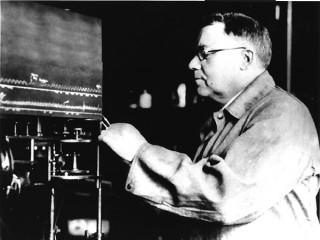
Walter Bradford Cannon biography
Date of birth : 1871-10-19
Date of death : 1945-10-01
Birthplace : Prairie du Chien, Wisconsin,U.S.
Nationality : American
Category : Science and Technology
Last modified : 2012-01-03
Credited as : scientist, Fight or flight response, The Wisdom of the Body
0 votes so far
He coined the term fight or flight response, and he expanded on Claude Bernard's concept of homeostasis. He popularized his theories in his book The Wisdom of the Body, first published in 1932.
In medical school, studying the mechanics of swallowing, Walter Bradford Cannon devised the bismuth or barium meal, adding heavy salts to foodstuffs to allow x-rays to study the mechanism of swallowing and movement of digestive organs. He researched the physiology of emotion, finding that in some animals peristaltic waves in the stomach cease when the animal is panicked, and later described the adrenaline flood that triggers response in emergency situations as "fight or flight response". He also studied psychosomatic response, chemical neurotransmission, and the body's systems for maintaining steady states -- for which he coined the term "homeostasis".
Cannon was 46 years old when World War I broke out, and immediately enlisted in the Army. He was assigned to medical research of traumatic shock among the injured, represented the US at the 1918 inter-allied conference on gas warfare, oversaw the research unit at the Army's Central Medical Laboratory in Dijon, France, and received the Distinguished Service Medal. Before and after the war, he took public stands against fascist governments' interference with science, defended animal research from criticism by anti-vivisectionists, and called eloquently for war to be replaced with athletic competitions. He is the namesake of Mount Cannon in Glacier National Park, the southwest peak of which was first scaled by Cannon and his wife on their honeymoon in 1901.
In 1945 Cannon summarized his career in physiology by describing his focus at different ages:
Age 26 - 40: digestion and the bismuth meal
Age 40 - 46: bodily effects of emotional excitement
Age 46 - 51: wound shock investigations
Age 51 - 59: stable states of the organism
Age 59 - 68: chemical mediation of nerve impulses (collaboration with Arturo Rosenblueth)
Age 68 + : chemical sensitivity of nerve-isolated organs
Author of books:
-A Laboratory Course in Physiology (1910)
-The Mechanical Factors of Digestion (1911)
-Bodily Changes in Pain, Hunger, Fear and Rage (1915)
-Traumatic Shock (1923)
-The Wisdom of the Body (1932)
-Digestion and Health (1936)
-Autonomic Neuro-Effector Systems (1937, with Arturo Rosenblueth)
-The Way of An Investigator (1945, memoir)
















